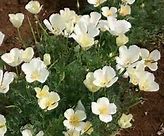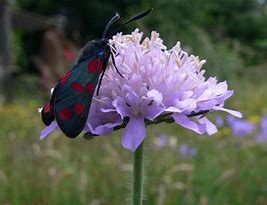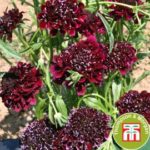Meconopsis Betonicifolia and Alba – Himalayan Blue & White Poppy 2018

I have today received fifty seeds of Meconopsis Betonicifolia from Premier seeds for another attempt to get a Himalayan blue poppy into my garden. I have bought seeds and young plants previously but have yet to see a blue poppy. This year I have bought seeds of the white variety, Alba, too. I have put the seeds into the fridge for stratification and will leave them there for 14 days. Its 21st March today so I can sow them all on the 5th of April. The blue seeds have been sown today, 8th April 2018, some on the surface of a large pot and some into the gravel garden.
 A perennial poppy originating from the Himalayas, famous for its unique blue flowers. It requires a shaded cool position in moist soil in order to thrive. Can be tricky to successfully propagate and cultivate. Height: 2-3′. The seed must be stratified for 14-21 days in the fridge in order to break the seeds dormancy. Sow between Jan -Mar in good free draining seed compost with a high grit content covering the seed only with the finest sprinkling of compost or vermiculite. Acclimatise to outdoor conditions in late spring and plant out when a good size in a shaded position with deep, moist soil 18-24in apart. Protect from slugs and snails when young.
A perennial poppy originating from the Himalayas, famous for its unique blue flowers. It requires a shaded cool position in moist soil in order to thrive. Can be tricky to successfully propagate and cultivate. Height: 2-3′. The seed must be stratified for 14-21 days in the fridge in order to break the seeds dormancy. Sow between Jan -Mar in good free draining seed compost with a high grit content covering the seed only with the finest sprinkling of compost or vermiculite. Acclimatise to outdoor conditions in late spring and plant out when a good size in a shaded position with deep, moist soil 18-24in apart. Protect from slugs and snails when young.

Loved both for their flowers and their seeds Poppies come from a range of families. the best known of these, Meconopsis, includes the Himalayan Blue Poppy and Welsh Poppy, while the Papaver family includes the Iceland poppy and Oriental Poppy.
There are both annual and perennial types. The perennial poppies include the Himalayan blue poppy. Plants can be grown from seed and will flourish in pots or containers as well as naturalising in the garden.
Poppy seeds do not need to be deeply planted, most varieties need light to germinate so a lightly cover at best is all that is required. Sow poppy seeds during early autumn or early spring, when germination may take place in 14 to 30 days at 70F, however, the seeds will germinate erratically and should be pricked out as they become large enough to handle, individually into 3-inch pots or as groups in 5-inch pots. Poppy plants do not transplant particularly well they are very sensitive to root disturbance so be very careful when potting on or use coir cells which can be planted into the final position without disturbing the roots. Grow on until the pots are full of roots and plant into the garden or patio after the last frost. Poppies need spacing at about 12-14 inches. Most poppies prefer sun but will tolerate semi-shade. Take care when watering to avoid washing away seeds or any new shoots. Misting is best.
 The Hardy Himalayan Blue poppy – Meconopsis Betonicifolia is a beautiful, short-lived perennial coveted by gardeners for its striking, large blue flowers. It can reach an overall height of 1.2m and grows from a rosette of hairy, oblong leaves. Erect leafy stems are produced from the base and bear a succession of clear blue poppy-like flowers 8-10cm in width with contrasting yellow stamens. It was discovered by Lt. Col. Frederick Marshman Bailey in 1912 during the course of an exploration of the Tsangpo river gorge in Tibet. Bailey pressed a single bloom in his wallet and several weeks later sent it to David Prain, the Director of Kew Gardens. On the evidence of this single tattered specimen Prain believed that Bailey had found an entirely new species of Asiatic poppy and named it in his honour – Meconopsis baileyi.
The Hardy Himalayan Blue poppy – Meconopsis Betonicifolia is a beautiful, short-lived perennial coveted by gardeners for its striking, large blue flowers. It can reach an overall height of 1.2m and grows from a rosette of hairy, oblong leaves. Erect leafy stems are produced from the base and bear a succession of clear blue poppy-like flowers 8-10cm in width with contrasting yellow stamens. It was discovered by Lt. Col. Frederick Marshman Bailey in 1912 during the course of an exploration of the Tsangpo river gorge in Tibet. Bailey pressed a single bloom in his wallet and several weeks later sent it to David Prain, the Director of Kew Gardens. On the evidence of this single tattered specimen Prain believed that Bailey had found an entirely new species of Asiatic poppy and named it in his honour – Meconopsis baileyi.
8th April 2018 I have sown seeds of Corn Poppy White Bridal Silk. These look so beautiful I hope that they will establish well in the garden. I have sown them directly into the garden. I bought the seeds from Premier Seeds. Corn Poppy Papaver Rhoeas White Bridal Silk is a new stunning introduction to the well known Red Field Corn Poppy. The pure white colour with tissue paper-like petals make beautiful displays if sown in drifts. The flowers can reach 20 inches tall. I can’t wait.
- Surface sow sparingly in a sunny location with well drained soil from late summer to very early spring.
- The seed needs the winter cold to break its natural dormancy.
- For best results the variety needs recently disturbed soil in order to get established.
- Germinates in early spring as the soil warms.
- Readily self-seeds.
- Benefits from being cut short in late summer after seeding.




 Peas are a cool season crop well suited to the UK climate. Peas can be direct sown outdoors from March to June once the soil has warmed up. Using cloches will help the earliest crops to germinate. In milder areas some hardy early maturing cultivars can be sown in late autumn for overwintering and producing particularly early crops. For a continuous crop it’s a good idea to sow a new batch of peas every 10-14 days. Alternatively, try growing different early and Maincrop varieties that will mature at different times throughout the growing season. Water regularly once pea plants start to flower to encourage good pod development. You can reduce water loss by applying a thick mulch of well rotted manure or compost to lock moisture into the soil. Don’t feed peas with nitrogen rich fertilisers as this can create leafy growth instead of producing pea pods. In most cases peas won’t require any extra feed.
Peas are a cool season crop well suited to the UK climate. Peas can be direct sown outdoors from March to June once the soil has warmed up. Using cloches will help the earliest crops to germinate. In milder areas some hardy early maturing cultivars can be sown in late autumn for overwintering and producing particularly early crops. For a continuous crop it’s a good idea to sow a new batch of peas every 10-14 days. Alternatively, try growing different early and Maincrop varieties that will mature at different times throughout the growing season. Water regularly once pea plants start to flower to encourage good pod development. You can reduce water loss by applying a thick mulch of well rotted manure or compost to lock moisture into the soil. Don’t feed peas with nitrogen rich fertilisers as this can create leafy growth instead of producing pea pods. In most cases peas won’t require any extra feed.











 I ordered these seeds from Seekay not realising that there would only be ten in the packet. Not much room for grower error. This variety of Vinca is said to be ideal for container growing. The plants grow 10 – 15 cm in height with a spreading, trailing habit. Mediterranean mix has a good range of colours from red to pure white. The plants should flower from late spring to late summer. Having read the instruction I have decided to plant the seeds singly into 3″ pots rather than a tray so cutting out the need to move them. These ten seeds have gone in today, 9th March 2018. I have used 3″ pressed card pots so that I can put the whole thing directly into the garden soil when they are big enough.
I ordered these seeds from Seekay not realising that there would only be ten in the packet. Not much room for grower error. This variety of Vinca is said to be ideal for container growing. The plants grow 10 – 15 cm in height with a spreading, trailing habit. Mediterranean mix has a good range of colours from red to pure white. The plants should flower from late spring to late summer. Having read the instruction I have decided to plant the seeds singly into 3″ pots rather than a tray so cutting out the need to move them. These ten seeds have gone in today, 9th March 2018. I have used 3″ pressed card pots so that I can put the whole thing directly into the garden soil when they are big enough.
 Scabiosa Butterfly Blue is a Lovely, lavender blue, pincushion like flower blooming from July to September, held on delicate stems above clumps of lance shaped, grey green leaves this long flowering blue scabious is ideal for a sunny, well drained rock garden or container planting. As its name suggests, the charming pincushion like flowers are highly attractive to butterflies and they make very pretty additions to fresh and dried flower arrangements.
Scabiosa Butterfly Blue is a Lovely, lavender blue, pincushion like flower blooming from July to September, held on delicate stems above clumps of lance shaped, grey green leaves this long flowering blue scabious is ideal for a sunny, well drained rock garden or container planting. As its name suggests, the charming pincushion like flowers are highly attractive to butterflies and they make very pretty additions to fresh and dried flower arrangements.

 Today would have been Adam’s birthday. Had he lived he would have been 44 today. My heart is heavy and my mind still trying to make sense of what has happened. He has been gone from our lives for over two years. His life, though too short, was after all, a magnificent story. He has left us all with amazing memories for which I am grateful. He was a very positive person so I try always to think, what would Adam do, when I am faced with a decision to make. Love you forever my lovely boy.
Today would have been Adam’s birthday. Had he lived he would have been 44 today. My heart is heavy and my mind still trying to make sense of what has happened. He has been gone from our lives for over two years. His life, though too short, was after all, a magnificent story. He has left us all with amazing memories for which I am grateful. He was a very positive person so I try always to think, what would Adam do, when I am faced with a decision to make. Love you forever my lovely boy. I have twelve different varieties in my tomato seed box. They are all old seeds. I have just read my post from last year and my message to myself was don’t grow any tomatoes next year. However, I have sown a selection of last years seeds to test germination. They are sitting on the computer box for a little bottom heat. The photographs are of previous success for inspiration. I have sown a few varieties including Gardeners Delight, Ildi, Black Opal, Black Cherry and Tigerella.
I have twelve different varieties in my tomato seed box. They are all old seeds. I have just read my post from last year and my message to myself was don’t grow any tomatoes next year. However, I have sown a selection of last years seeds to test germination. They are sitting on the computer box for a little bottom heat. The photographs are of previous success for inspiration. I have sown a few varieties including Gardeners Delight, Ildi, Black Opal, Black Cherry and Tigerella.